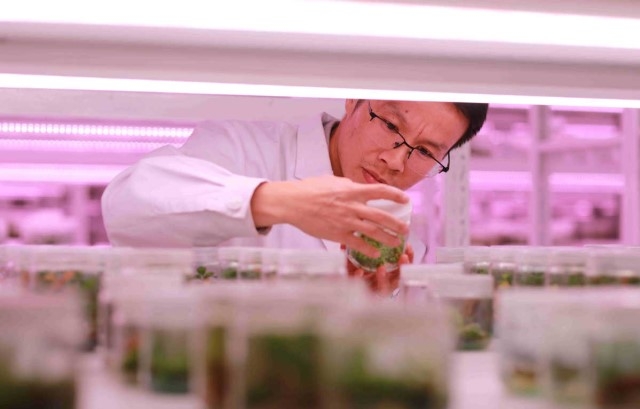
A scientist examines a plant. CHINA DAILY
“If the world ends one day, these collections will bring hope of a new beginning to life on Earth,” said Li Pei, a staff member at the Germplasm Bank of Wild Species, or GBOWS, in Yunnan province.
“如果有一天世界末日来临,这些种质资源将为地球带来新生命的希望。”位于云南省的中国西南野生生物种质资源库(GBOWS)工作人员李培(音)说:
Founded in 2007, GBOWS is a research and preservation facility for rare and endangered plants and animals. It is the largest in Asia in terms of species.
中国西南野生生物种质资源库于2007年建成,是一个研究、保藏珍稀濒危动植物的综合设施,也是亚洲最大的野生生物种质资源库。
According to China Daily, GBOWS has preserved 85,046 seed accessions from 10,601 species and 60,262 biosamples of 2,203 wild animal species and domestic animal breeds.
据《中国日报》报道,中国西南野生生物种质资源库已保存植物种子10601种、85046份,野生及家养动物种质资源2203种、60262份。
“The number of seed accessions is close to that of the world’s biggest seed bank – the Millennium Seed Bank in the United Kingdom,” Li said.
李培(音)说:“种质资源库的种子数量接近于世界最大的种子库——英国的‘千年种子库’的存量。”
With two in five plant species at risk of extinction, she said it is a race against time to protect the nation’s incredible plant life.
李培(音)称,由于五分之二的植物濒临灭绝,保护国内那些不可思议的植物生命是在与时间赛跑。
So how does the bank work? Scientists collect endangered and useful wild species and send them to the seed bank. For future study, collectors have to record details of the plant, including where it was found, its size and the number of individual plants in the habitat.
那么,中国西南野生生物种质资源库是如何运作的?科研人员采集濒危的、有用的野生物种,并将种子送到种质资源库。而为了将来的研究,接收种子的科研人员必须记录这种植物的详细信息,包括采集地点、种子的体积、周围环境中单株植物的数量等。
Once the seeds arrive at GBOWS, they’re dried and preserved in a room with 15 percent humidity. Next, they’re cleaned and separated from debris. After that, X-rays confirm that the seeds are undamaged and no insects are hidden inside. The seeds are then frozen, stored in glass bottles and placed in huge freezers at -20 C for long-term storage. Each container has a barcode that can be scanned to enable scientists to view information about the seeds inside.
中国西南野生生物种质资源库接收种子后,会对种子进行再干燥处理,并将其放置在相对湿度15%的环境中。接下来,科研人员会将种子清理并分离,还会抽取种子进行X光拍照,确保种子无损伤、无虫害。随后,种子将被冷冻,储存在玻璃瓶中,放置在零下20摄氏度的巨大冷库中长期保存。每个玻璃瓶都有一个条码,科研人员可以通过扫描条码来查看瓶内种子的信息。
The bank in Yunnan works with international partners on collecting backup specimens, exchanges and research. It holds 2,176 sets of seeds from 45 countries and regions, with each set containing thousands of individual seeds.
中国西南野生生物种质资源库坐落于云南,与国际合作伙伴开展备份标本的收集、交流和研究。该种质资源库拥有来自45个国家和地区的2176组种子,每组包含数千个单独的种子。
“As China has rich and unique biological resources, we aim to further enhance our collections and conduct deeper research, in expectation of contributing more to biodiversity conservation, not only in China but the world,” Li Pei said.
李培(音)说:“中国拥有丰富且独特的生物资源,我们将进一步加强种质资源保藏,开展更深入的研究,为中国乃至世界的生物多样性保护作出更大的贡献。”



















